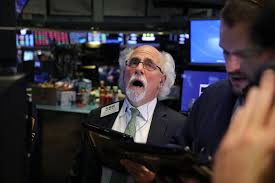Stock Investing Has Been Easy for a While. It May Get Harder in a Hurry

For most of the past two years, stock investors might as well have been living inside a Ronco infomercial, where “set it and forget it” was the byword. Adding money each month to an ETF or two was usually as easy as it was effective, as the S&P 500 marched ever upward, setting record high after record high.
Now that the S&P 500 and the Dow Jones Industrial Average have both lost 7% in the past six trading days—with about 5% losses coming in the past two days alone—it’s starting to look like the chore of making money in stocks is about to get more complex.
Of course, throughout the bull run in U.S. stocks, there have been troubling selloffs—typically corrections seen as necessary for stocks to move higher longer term. Between Jan. 26 and Feb. 8 of this year, for example, the S&P 500 lost more than 10% of its value on concerns about higher inflation. Inflation remained low, however, and the stock market was soon back to reaching new highs.
That may be the case again this time around, although some market observers are arguing that there are reasons why we’re in for more declines. Craig Johnson, a noted market technician at Piper Jaffray, pointed out on CNBC that the S&P 500 index has broken below its 50-day and 200-day moving averages this week, two bearish indicators that could signal more declines to come.
“When you start looking around the world and you start looking at the big breakdown in the [German stock index] DAX, and the Shanghai Composite and what’s going on in the bond market and financials sectors not participating in this advance, there’s more problems out there that we need to pay attention to,” Johnson said. “I think we’re going to see a deeper sell-off.”
A grimmer view came from Felix Zulauf, the president of Zulauf Asset Management, a Swiss hedge fund. “This is the beginning of a structural bear market that will take a shape that is very different from 2008. 2008 was a one-year waterfall decline. This is going to be a managed bear market by authorities: The upside is limited and the downside they have to limit,” Zulauf said on an interview with Bloomberg.
“When the market sells off 20%, 25% or so, they will come in to support it, and the market rallies again. Then it fades again and it goes deeper than the last time. This is a very serious, very difficult market to have. For traders, it’s great. For buy-and-hold index buyers, it’s very bad news,” Zulauf said.
There are a few key difference between this selloff and the one in early February. The biggest is the escalating trade war between the U.S. and China, which is threatening companies from Ford to Walmart. Interest rates are more likely to keep going higher, at least if Fed Chairman Jerome Powell’s recent comments are any indication. Stocks in Europe, China and emerging markets are also slumping as forecasts for global growth are being revised downward. All that has expensive stocks like Amazon—still trading at 136 times its earnings—falling back to earth.
As investors learned during and after the financial crisis a decade ago, riding out the storm for a few years can protect against losses in the long term. In the short-term, there are time-honored strategies such as hedging investments with stock options or good-old-fashioned stockpicking—a lost art during the recent bull market—that can help. But most of these involve much more homework on the part of investors. It may soon be time to forget “set it and forget it.”


